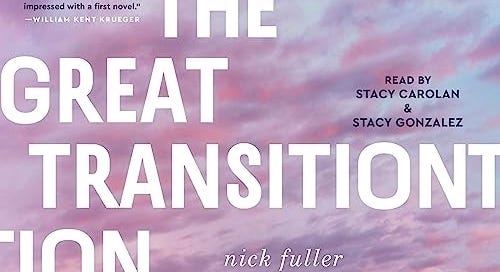BookLife Review: The Great Transition, by Nick Fuller Googins
climate crisis, post-apocalyptic future, Greenland, New York, climate crisis prevention and recovery, romance, adolescent
Author Nick Fuller Googins creates a post-climate crisis apocalyptic world, and brings the reader on one family’s roller coaster ride through this universe. The Great Transition in the title refers to the collapse of society as a result of worldwide inaction in the face of impending climate crisis and the rescue and recovery of the world by workers who bond together in solidarity to transition the world to climate-sensitive and ecologically sound practices to save humanity. The villains of the story are the corporations and the wealthy, and to some extent everyday citizens, who ignored the warning signs and did too little to avert the impact of the climate crisis on the world biosphere.
In this future world, we meet Emi Vargas Brinkman, a highly anxious fifteen year-old single child of Transition heroes, Kristina Vargas and Larch Brinkman. Kristina survived extreme heat and wildfires of what was Mexico. She and her family fled, and she and her sister were separated from her parents in gruesome immigration camps. Larch’s parents were victims of a Maine wildfire, leaving him alone at 15. Orphaned (or effectively orphaned), Kristina and Larch each find community in the cooperatives working to rescue the planet, putting out wildfires, building flood breaks, deconstructing buildings for essential materials and resources. They each achieve a level of fame in their work and encounter one another on a wildfire deployment in the West. They fall in love as they continue their service assignments and ultimately move to the new-age community of Nuuk, Greenland where they have their child, Emiliana.
This is not a happily-ever-after story. Can a post-apocalyptic story ever be, I wonder? Kristina is deeply wounded by her past and remains angry; she is a beacon to those who might forget the past or become complacent with the present. Kristina continues regular voluntary in-service deployments and is hostile to any sort of ease. Larch, by contrast, is comfortable with his years of extraordinary service, and readily embraces fatherhood and his post-Transition life in Nuuk, Greenland. Their daughter, Emi, is a charming and complex fifteen year-old. Her frustration with her parents rings true to her age. I found Kristina’s harping at Emi about her good fortune and her own life of extreme hardship somewhat challenging. Clearly Kristina suffered genuine trauma. However, it not only damaged her, but it creates generational trauma when she relentless deposits it upon her teenage daughter. Emi’s eating disorder is both unfortunate and perhaps all-too-realistic, as a symbol of youth anxiety over climate uncertainty. Emi’s eating disorder seems as times to go largely unaddressed by her parents and is arguably slightly romanticized since her non-eating is likely incompatible with daily function let alone her running pastime and adventure antics. Nonetheless, Emi’s anxiety and eating patterns are a clear indicator of the instability of her world and her underlying fear throughout the novel.
Crisis erupts when Kristina disappears around a Day Zero holiday (the anniversary of the planet reaching zero emissions). Larch and Emi go in search of her and it becomes increasingly obvious that Kristina is involved in a subversive movement to bring justice to aging corporate climate control criminals. During their search for Kristina, Emi is kidnapped and held as a hostage to prevent more vigilante justice by Kristina and her colleagues. A furious search and rescue ensues.
As I am neither a fantasy or post-apocalyptic future novel enthusiast, the world-building necessary to create a successful science fiction and apocalyptic future novel challenged me as a reader. That said, once sufficient world-building groundwork has been laid, Groggins does an admirable job of building suspense and tension as the novel unfolds and the clock ticks down on the window to rescue Emi. Furthermore, Groggins’ depiction of what a future devoid of meaningful action toward climate crisis solutions might look like is both grim and hopeful-a timely reminder that the crisis is real and the future is now.




